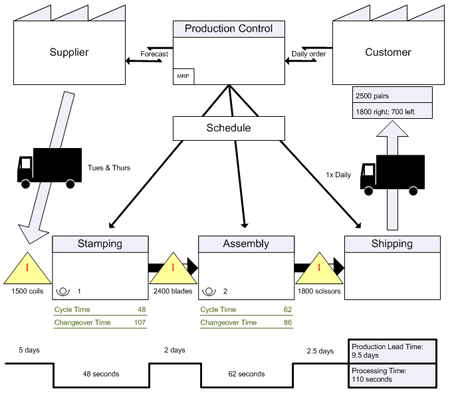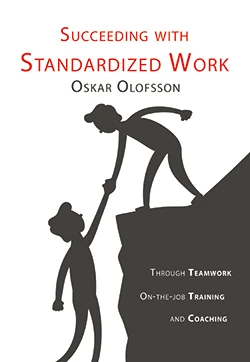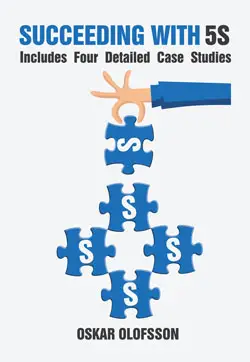Definition
A "value stream" shows the movement of what the customer values. It includes the materials and processes which contribute to what the customer purchases. It is unlikely to include the cardboard boxes in which the product is shipped to the customer.
Value Stream Mapping (VSM) is the technique of drawing a "map" showing how materials or information flow from supplier to customer. It is used in process-improvement projects: map the current process, decide where to make improvements, and map the desired process.
The Toyota company is credited with originating this methodology under the name "material and information flow mapping".
A VSM diagram is a high-level diagram – it does not examine the details within a processing step.
VSM does not address "how to improve the product" or "how to add more value to the product". (That is the role of "Value Chain Analysis"). VSM addresses how the current product is manufactured, and asks whether a step adds value to that product.
Components
A VSM diagram includes:
- The overall control process
- Suppliers and the delivery methods
- Inputs from the suppliers
- The work processes (including inventory warehouses) through which materials move
- Outputs – both the desired and waste outputs
- Customers and the delivery methods
- The information flow that co-ordinates these entities
- The average times required in each process: both actual working time and the overhead time
- The average labor required in each process
- Summary of the working and overhead times
Standard icons are used to represent suppliers, delivery methods, etc.
How to draw a map
The major steps in VSM are:
- Identify the process to be mapped.
- For example: choose a process that consumes a significant portion of the organization's resources, or a process that should contribute more profit.
- Typically a manufacturer will focus on a manufacturing process. However, it may be useful to map the sales cycle, for example, to uncover inefficiencies in defining customer requirements.
- The scope is important: define the start and end points. Typical VSM starts with external suppliers and ends with external customers. However, there is no reason to avoid a VSM project dealing with an internal process – but this must be a conscious decision rather than an oversight.
- Draw the current process.
- Both managers and front-line workers should contribute to the mapping effort. VSM starts with the actual current process, not with the idealized "we should do this" process. So include the front-line workers in this stage.
- Include wait times – do orders or materials arrive during off-shift hours? Are warehouse tickets generated overnight, rather than on request?
- Wait times might be caused by items or processes that were excluded from the original scope. For example, if those shipping boxes are often delayed because of a problem with the cardboard processor – that fact would be noted here.
- Assess the current value stream.
- The major questions are: "Does this step add value (for the customer)? How much? Using what resources (of labor and elapsed time)? How much waste is generated"?
- In manufacturing: fabrication; treatment; and assembly steps usually add value.
- Some paperwork may be "overhead" but still be mandatory. Keeping records for tax or regulatory purposes cannot be avoided. However, interrupting a manufacturing process to maintain a paper logbook may be a complete waste, if automated counters could produce the same information.
- Pure warehousing or storage is usually a waste of time.
- Identify long wait times between processes.
- Create the future value stream.
- Eliminate or reduce bottlenecks, non-value-adding steps, waste, and storage.
- Plan how to implement the changes.
- Implement.
- Review (and repeat the process if warranted).
Summary
Value Stream Mapping is a valuable tool in analyzing existing processes. It identifies:
- Bottlenecks and delays
- Steps which add no customer-oriented value to the product
By Oskar Olofsson
Advanced Visual Management Platform
- Unleash digital power on 5S, Improvements, Safety, Maintenance, and more
- Drive success with Lean and Operational Excellence practices
- Perfectly tailored for small to medium-sized manufacturing facilities
- Experience it first-hand with our free version - Embark on your journey today!
Create Your Free Account








